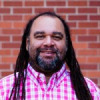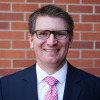Students in Iowa State University's American Sign Language program test their skills during a visit to the Iowa School for the Deaf. Video by Dave Olson
Editor’s note: The word deaf is capitalized when referring to the Deaf culture and someone who identifies as part of the Deaf community.
AMES, Iowa – Language is about more than words. Whether they are written, spoken or signed, words are part of a language that cannot be separated from the culture.
This philosophy is the foundation of the American Sign Language program that Jonathan Webb started nearly four years ago at Iowa State University. It’s a program that was discussed for years before it became a reality, but one that Webb had no doubt would flourish once the first class was offered.
“I knew students were going to be intrigued with the idea of communicating in a visual format without the use of words as they knew it, and that the program would simply grow,” said Webb, a lecturer in the Department of World Languages and Culture.
And he was right. But growing the ASL program by numbers was not as important to Webb as building an understanding about the Deaf culture and creating awareness of an underrepresented population on campus. Less than 1 percent of Iowa State students seek assistance from Student Disability Resources because they are deaf or hard of hearing, and there is only one deaf faculty member. A big reason for the lack of understanding is related to the lack of interaction that students, faculty and staff have with someone who is deaf, said Webb, who started signing when he was 10 years old.
That’s why he’s made culture such a vital component of ASL classes. Students not only learn to sign, but are required to interact with members of the deaf community on campus, in Ames and Iowa (in the video above ISU students visit the Iowa School for the Deaf). As with any new language, there is only so much to be gained in the classroom, and putting those language skills to use provides an entirely different level of learning for students.
“We’ve tried to be innovative in how we infuse the community into our classrooms; I think it’s just vital,” Webb said. “There is a need to not just appropriate someone’s language, but pay their culture and their community their due respect.”
Deaf, but not broken
It’s not unusual for Michael Ballard to have students tell him they’re a little nervous about taking his ASL class. He understands – learning a new language isn’t easy – but he knows their anxiety is not entirely about the language. It’s the fact that Ballard is Deaf.
Anxiety and even shock are pretty universal responses Ballard encounters when meeting someone for the first time. And much like Webb, Ballard says the reaction comes from a lack of experience. In a rural state, such as Iowa, people don’t regularly see or interact with deaf people in the community, and so they’re unsure as to how they should react.
Ballard doesn’t take offense. He says most people, just like his students, respond positively after that initial shock and find a way to communicate, whether it’s through an interpreter in the classroom or with paper and pen at the doctor’s office. Ballard says it’s the rare situations in which people refuse to make an effort at communication that sting. He wants people to understand that being D/deaf is not a barrier and does not invoke feelings of deficit.
“We as a society take this pathological view of deafness, where we see that something is missing, that an individual is broken and they need to be fixed,” Ballard said. “Members of the D/deaf community do not feel in any way that they’re experiencing a deficit in their daily lives. The impact of deafness is often more heavily attributed to a societal attitude, rather than the actual biological and natural ability to hear or not hear.”
That’s not to say all things are equal for the D/deaf community. For example, most programs and events – whether on campus or at a local venue – do not provide interpreters. Someone who is deaf or hard of hearing must arrange for their own interpreter, which isn’t always easy. Ballard says the pool of qualified interpreters in Iowa is limited. But he is optimistic that some of the students in his ASL classes will continue learning the language and one day become interpreters.
More than just hand signals
It can take seven or eight years before someone is fluent in ASL – a commitment that partially explains why there are so few interpreters. The language is complex and very visual. The full meaning of the signs is found in the body language and facial expressions. Ballard says 90 to 95 percent of the language usage in ASL takes place in the upper portion of the body, or what’s called the signing box.
“When you’re looking from the waist up, you’re using that body language more to define temporal and spatial aspects. You utilize that to identify future versus past events, to identify where things are located in relation to each other, to identify multiplicity, plurality,” Ballard said.
Webb offered this example on facial grammatical markers: “If I say, ‘What’s going on?’ and my eyebrows are up, that indicates that it’s a rhetorical question. If my eyebrows are down, that’s letting you know it’s a direct question and I’m requesting an answer.”
There’s a point every semester as the class starts exploring these nuances, when students realize there’s more to ASL than simply memorizing a series of signs. That misconception is one reason a lot of students take the class, thinking it will be easier than learning a new spoken language, Webb said. But even when they learn that’s not the case, they stick with it.
“The vast majority of students, even if they come just for the language requirement, become converts. There’s this awakening that they experience in relation to ASL,” Webb said. “Even if they struggle, they struggle through it, and they’re able to look back and recognize it as a valuable experience.”
Aside from promoting the ASL program, Ballard wants to encourage more deaf students, particularly at the graduate level, to continue their education at Iowa State. Not only would it help dispel some of the misconceptions and create more awareness, it would be a great benefit to the Deaf community.
“Parents with deaf children would have mentors and role models to look up to,” Ballard said. “They can see that their children can grow up to be successful. Deaf people can do things and it’s alright to be deaf, it’s more than OK, it’s awesome.”
Contacts
Michael Ballard, World Languages & Cultures, ballardm@iastate.edu, 515-337-0548
Jonathan Webb, World Languages & Cultures, jwebb@iastate.edu, 515-294-2306
Angie Hunt, News Service, amhunt@iastate.edu, 515-294-8986
Quick look
Language is about more than words. Whether they are written, spoken or signed, words are part of a language that cannot be separated from the culture. This philosophy is the foundation of the American Sign Language program at Iowa State University.
Quotes

Jonathan Webb
“We’ve tried to be innovative in how we infuse the community into our classrooms; I think it’s just vital. There is a need to not just appropriate someone’s language, but pay their culture and their community their due respect.”
Jonathan Webb, lecturer in American Sign Language program

Michael Ballard
“Members of the D/deaf community do not feel in any way that they’re experiencing a deficit in their daily lives. The impact of deafness is often more heavily attributed to a societal attitude, rather than the actual biological and natural ability to hear or not hear.”
Michael Ballard, lecturer in American Sign Language program